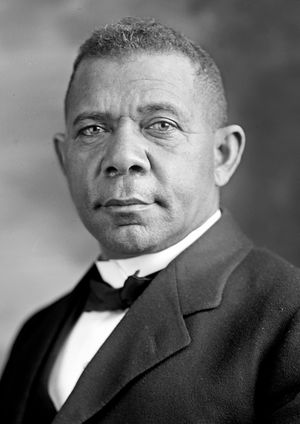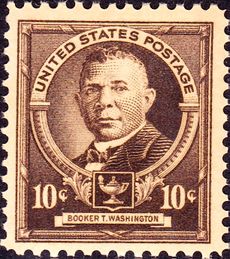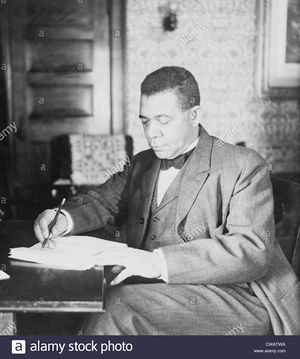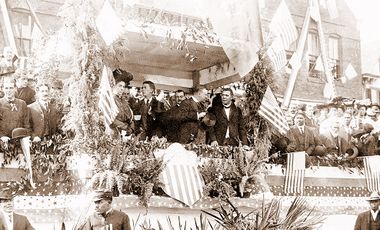بوكر تي واشنطن
Booker T. Washington | |
|---|---|
 Booker T. Washington in 1905 | |
| وُلِدَ | Booker Taliaferro Washington أبريل 18, 1856 Hale's Ford, Virginia, U.S. |
| توفي | نوفمبر 14, 1915 (aged 59) Tuskegee, Alabama, U.S. |
| المثوى | Tuskegee University |
| المدرسة الأم | Hampton Normal and Agricultural Institute Wayland Seminary |
| المهنة | Educator, author, and African American civil rights leader |
| الحزب | Republican |
| الزوج | Fannie N. Smith (1882–1884, her death) Olivia A. Davidson (1886–1889, her death) Margaret Murray (1893–1915, his death) |
| الأنجال | 3 |
| التوقيع | |
بوكر تاليافرّو واشنطن (Booker Taliaferro Washington ؛ 18 أبريل 1856 – 14 نوفمبر 1915) كان مربياً ومؤلفاً وخطيباً ومستشاراً أمريكياً لعدد من رؤساء الولايات المتحدة. وبين 1890 و 1915، كان واشنطن زعيماً بارزاً في مجتمع الأمريكان الأفارقة وفي النخبة السوداء المعاصرة.[1] Washington was from the last generation of black American leaders born into slavery and became the leading voice of the former slaves and their descendants. They were newly oppressed in the South by disenfranchisement and the Jim Crow discriminatory laws enacted in the post-Reconstruction Southern states in the late 19th and early 20th centuries.
Washington was a key proponent of African-American businesses and one of the founders of the National Negro Business League. His base was the Tuskegee Institute, a historically black college he founded in Tuskegee, Alabama. As lynchings in the South reached a peak in 1895, Washington gave a speech, known as the "Atlanta compromise", which brought him national fame. He called for black progress through education and entrepreneurship, rather than trying to challenge directly the Jim Crow segregation and the disenfranchisement of black voters in the South.
Washington mobilized a nationwide coalition of middle-class blacks, church leaders, and white philanthropists and politicians, with a long-term goal of building the community's economic strength and pride by a focus on self-help and schooling. With his own contributions to the black community, Washington was a supporter of racial uplift, but secretly he also supported court challenges to segregation and restrictions on voter registration.[2]
Black activists in the North, led by W. E. B. Du Bois, at first supported the Atlanta compromise, but later disagreed and opted to set up the National Association for the Advancement of Colored People (NAACP) to work for political change. They tried with limited success to challenge Washington's political machine for leadership in the black community, but built wider networks among white allies in the North.[3] Decades after Washington's death in 1915, the civil rights movement of the 1950s took a more active and progressive approach, which was also based on new grassroots organizations based in the South, such as Congress of Racial Equality (CORE), the Student Nonviolent Coordinating Committee (SNCC) and Southern Christian Leadership Conference (SCLC).
Washington mastered the nuances of the political arena in the late 19th century, which enabled him to manipulate the media, raise money, develop strategy, network, push, reward friends, and distribute funds, while punishing those who opposed his plans for uplifting blacks. His long-term goal was to end the disenfranchisement of the vast majority of African Americans, who then still lived in the South.[4] His legacy has been very controversial to the civil rights community, of which he was an important leader before 1915. After his death, he came under heavy criticism for accommodationism to white supremacy. However since the late 20th century, a more balanced view of his very wide range of activities has appeared. As of 2010, the most recent studies, "defend and celebrate his accomplishments, legacy, and leadership".[5]
ولدت بوكر تي واشنطن في 5 أبريل 1856 ، في مزرعة جيمس بوروز في مجتمع هيل فورد ، فرجينيا. كانت والدته ، جين ، طباخة المزرعة ، وكان والده رجلاً أبيض من مزرعة قريبة. استذكر بوكر في وقت لاحق تلك اللحظة ، في أوائل عام 1865
. . . . . . . . . . . . . . . . . . . . . . . . . . . . . . . . . . . . . . . . . . . . . . . . . . . . . . . . . . . . . . . . . . . . . . . . . . . . . . . . . . . . . . . . . . . . . . . . . . . . . . . . . . . . . . . . . . . . . . . . . . . . . . . . . . . . . . . . . . . . . . . . . . . . . . . . . . . . . . . . . . . . . . . .
حياته
في صيف عام 1865 ، في سن التاسعة ، انتقل بوكر ، مع شقيقه جون وشقيقته أماندا ، مع والدتهم ، إلى مالدن في مقاطعة كاناوا بولاية فرجينيا الغربية للانضمام إلى زوج أمهم. كان الشاب واشنطن يعمل مع والدته وغيرهم من السود المحررين كحزم ملح وفي منجم للفحم. حتى انه وقع لفترة وجيزة كيد مستأجرة على متن باخرة. في النهاية ، تم تعيينه في منصب ربة منزل فيولا روفنر ، زوجة الجنرال لويس روفنر ، الذي كان يمتلك كل من فرن الملح ومنجم الفحم. فشلت العديد من بيوت المنازل الأخرى في إرضاء السيدة روفنر الشاقة والمنهجية ، ولكن مجهود بوكر ودقته يفيان بمعاييرها. شجعت السيدة روفنر ، بوكر الشباب على القيام بذلك ، كلما استطاع ذلك ، وحضر المدرسة ، وتعلم القراءة والكتابة. كما هو متوقع ، سرعان ما تطلع إلى تعليم أكثر مما كان متاحًا في مجتمعه.
بعد السفر من مالدن في سن السادسة عشرة ، التحقت واشنطن بمعهد هامبتون للنباتات والزراعة في هامبتون ، فرجينيا. يمكن للطلاب الفقراء مثل الحصول على مكان هناك من خلال العمل لدفع طريقهم. تأسست المدرسة العادية في هامبتون لغرض تدريب المعلمين السود ، وتم تمويلها في المقام الأول من قبل مجموعات الكنيسة والأفراد مثل وليام جاكسون بالمر ، وهو كويكر ، من بين آخرين. في نواح كثيرة ، عاد واشنطن الشاب إلى حيث بدأ ، ويكسب لقمة العيش من خلال المهام الوضيعة. ولكن وقته في هامبتون بشرت به بعيدا عن حياة العمل. بعد تخرجه من هناك في عام 1875 ، أمضى الصيف وهو يعمل نادل فندق ، قبل أن يعود إلى مالدن ، حيث عاش لمدة ثلاث سنوات. خلال هذه الفترة ، قام بتدريس المدرسة العامة ، وكتب رسائل وافتتاحيات للنهوض بمُثُل هامبتون ، وشارك في مناقشات المسابقات ، والتي عزز من خلالها سلطاته الخطابية وشحذ مهاراته في التحدث أمام الجمهور.
في عام 1878-1879 ، قضى واشنطن كطالب في مدرسة وايلاند في واشنطن العاصمة. من تلك التجربة ، كتب
في عام 1878 ، ذهبت إلى مدرسة وايلاند ، في واشنطن وقضيت
- سنة في الدراسة هناك. G.M.P. كان الملك د
- مدرسة وايلاند في حين كنت هناك. على الرغم من أنني كنت
- هناك ولكن لفترة قصيرة ، شخصية مسيحية عالية للدكتور
- قدم الملك انطباع دائم على عاتقي. الديني العميق
- جعلت الروح التي انتشرت الجو في وايلاند إعجاب
- ايون علي الذي أثق به سيبقى دائما. (السيرة الذاتية: قصة حياتي وعملي ، ص. 45). عند مغادرته المدرسة ، عاد للتدريس في هامبتون. بعد العامين التاليين ، أوصى به مسؤولو المعهد ليصبح أول مدير لمدرسة مماثلة يتم تأسيسها في ألاباما.
وفاته
Despite his extensive travels and widespread work, Washington continued as principal of Tuskegee. Washington's health was deteriorating rapidly in 1915; he collapsed in New York City and was diagnosed by two different doctors as having Bright's disease, related to kidney diseases. Told he only had a few days left to live, Washington expressed a desire to die at Tuskegee. He boarded a train and arrived in Tuskegee shortly after midnight on November 14, 1915. He died a few hours later at the age of 59.[6] His funeral was held on November 17, 1915 in the Tuskegee Institute Chapel and it was attended by nearly 8,000 people.[7]. He was buried nearby in the Tuskegee University Campus Cemetery.[8]
At the time he was thought to have died by congestive heart failure, aggravated by overwork. In March 2006, his descendants permitted examination of medical records: these showed he had hypertension, with a blood pressure more than twice normal, confirming what had long been suspected.[9]
At Washington's death, Tuskegee's endowment was close to $2 million.[10] Washington's greatest life's work, the education of blacks in the South, was well underway and expanding.[بحاجة لمصدر]
التكريم والتخليد
For his contributions to American society, Washington was granted an honorary master's degree from Harvard University in 1896 and an honorary doctorate from Dartmouth College in 1901.[بحاجة لمصدر]
At the center of Tuskegee University, the Booker T. Washington Monument was dedicated in 1922. Called Lifting the Veil, the monument has an inscription reading:
He lifted the veil of ignorance from his people and pointed the way to progress through education and industry.
In 1934 Robert Russa Moton, Washington's successor as president of Tuskegee University, arranged an air tour for two African-American aviators. Afterward the plane was renamed as the Booker T. Washington.[11]

On April 7, 1940, Washington became the first African American to be depicted on a United States postage stamp.[12]
من أقواله
- إن العبد الجديد الذي يبتهج في عبوديته أكثر كائن مثير للشفقة في الواقع
أعماله
- The Future of the American Negro – 1899
- الصعود من العبودية – 1901
- Character Building – 1902
- Working with the Hands – 1904
- Tuskegee & Its People (editor) – 1905
- The Negro in the South (with W. E. B. Du Bois) – 1907
انظر أيضاً
- African American literature
- Booker T. Washington High School (disambiguation)
- Booker T. Washington Junior College
- Booker T. Washington National Monument, in Virginia
- Booker T. Washington State Park (Tennessee)
- Double-duty dollar
- Hampton University, Virginia
- List of civil rights leaders
- List of things named after Booker T. Washington
- Ralph Waldo Tyler
- Roscoe Simmons
- Rosenwald School
المراجع
- ^ "Washington, Booker T." in Gale Contextual Encyclopedia of American Literature, (vol. 4, Gale, 2009), pp. 1626–1630. online
- ^ Pildes, Richard H. (2000-07-13). "Democracy, Anti-Democracy, and the Canon". Constitutional Commentary (in الإنجليزية). Rochester, NY. 17: 295–319. doi:10.2139/ssrn.224731. hdl:11299/168068. SSRN 224731.
- ^ Huggins, Nathan Irvin (2007). Harlem Renaissance (in الإنجليزية). Oxford University President. pp. 19–20. ISBN 978-0-19-983902-5.
- ^ Bieze, Michael Scott; Gasman, Marybeth, eds. (March 26, 2012). Booker T. Washington Rediscovered. Johns Hopkins UP. p. 209. ISBN 978-1-4214-0470-7.
- ^ Dagbovie, Pero Gaglo (2010). African American history reconsidered. Urbana. p. 145. ISBN 978-0-252-03521-0. OCLC 456551364.
{{cite book}}: CS1 maint: location missing publisher (link) - ^ "The Death of Booker T. Washington" (PDF). Booker T. Washington National Monument (National Park Service). Retrieved أبريل 5, 2018.
- ^ خطأ استشهاد: وسم
<ref>غير صحيح؛ لا نص تم توفيره للمراجع المسماة:0 - ^ خطأ استشهاد: وسم
<ref>غير صحيح؛ لا نص تم توفيره للمراجع المسماةgrave - ^ Dominguez, Alex (مايو 6, 2006). "Booker T. Washington's Death Revisited". Washington Post (in الإنجليزية الأمريكية). Associated Press. ISSN 0190-8286. Retrieved أبريل 5, 2018.
- ^ Brown, Angelique (يوليو 18, 2011). "Washington, Booker Taliaferro". Social Welfare History Project (in الإنجليزية الأمريكية). Virginia Commonwealth University. Retrieved أبريل 5, 2018.
- ^ Tucker, Phillip Thomas (2012). Father of the Tuskegee Airmen, John C. Robinson. Potomac Books. p. 58. ISBN 978-1-59797-487-5.
- ^ "African American Subjects on United States Postage Stamps - Who We Are - USPS". about.usps.com. Retrieved 2020-03-27.
المصادر الرئيسية
- Du Bois, W.E.B. (1903), "3", The Souls of Black Folk, Bartleby.
- Washington, Booker T. (September 1895), The Atlanta Cotton States Exposition Address, History Matters, GMU, http://historymatters.gmu.edu/d/39/.
- Washington, Booker T. (September 1896), "The Awakening of the Negro", The Atlantic Monthly 78, https://www.theatlantic.com/magazine/archive/1969/12/the-awakening-of-the-negro/5449/
- Washington, Booker T. (1901). Up from Slavery: An Autobiography. Garden City, NY: Doubleday.
{{cite book}}: Invalid|ref=harv(help); Unknown parameter|authormask=ignored (|author-mask=suggested) (help) Documenting the American South. Other online full-text versions available via Project Gutenberg, UNC Library - Washington, Booker T. (1906) [1901]. Up from Slavery: An Autobiography. New York: Doubleday, Page & Co.
{{cite book}}: Invalid|ref=harv(help); Unknown parameter|authormask=ignored (|author-mask=suggested) (help) - Washington, Booker T. (October 1903), "The Fruits of Industrial Training", The Atlantic Monthly 92, https://www.theatlantic.com/magazine/archive/1903/10/the-fruits-of-industrial-training/531030/
- Washington, Booker T. (December 1906). "A Farmers' College on Wheels". The World's Work: A History of Our Time. XIII: 8352–54. Retrieved 2009-07-10.
{{cite journal}}: Unknown parameter|authormask=ignored (|author-mask=suggested) (help) - Washington, Booker T. (October 1910). "Chapters From My Experience I". The World's Work: A History of Our Time. XX: 13505–22. Retrieved 2009-07-10.
{{cite journal}}: Unknown parameter|authormask=ignored (|author-mask=suggested) (help) - Washington, Booker T. (November 1910). "Chapters From My Experience II". The World's Work: A History of Our Time. XXI: 13627–40. Retrieved 2009-07-10.
{{cite journal}}: Unknown parameter|authormask=ignored (|author-mask=suggested) (help) - Washington, Booker T. (December 1910). "Chapters From My Experience III". The World's Work: A History of Our Time. XXI: 13784–94. Retrieved 2009-07-10.
{{cite journal}}: Unknown parameter|authormask=ignored (|author-mask=suggested) (help) - Washington, Booker T. (January 1911). "Chapters From My Experience IV". The World's Work: A History of Our Time. XXI: 13847–54. Retrieved 2009-07-10.
{{cite journal}}: Unknown parameter|authormask=ignored (|author-mask=suggested) (help) - Washington, Booker T. (February 1911). "Chapters From My Experience V". The World's Work: A History of Our Time. XXI: 14032–39. Retrieved 2009-07-10.
{{cite journal}}: Unknown parameter|authormask=ignored (|author-mask=suggested) (help) - Washington, Booker T. (April 1911). "Chapters From My Experience VI". The World's Work: A History of Our Time. XXI: 14230–38. Retrieved 2009-07-10.
{{cite journal}}: Unknown parameter|authormask=ignored (|author-mask=suggested) (help) - Washington, Booker T.; Harlan, Louis R.; Blassingame, John W. (1972). "Volume 1:The Autobiographical Writings". The Booker T. Washington Papers. University of Illinois Press. ISBN 978-0-252-00242-7.
{{cite book}}: External link in|chapterurl=|ref=harv(help); Unknown parameter|chapterurl=ignored (|chapter-url=suggested) (help) Fourteen-volume set of all letters to and from Booker T. Washington. - Washington, Booker T.; Harlan, Louis R.; Blassingame, John W. (1972). "Volume 14: Cumulative Index". The Booker T. Washington Papers. University of Illinois Press. Archived from the original on 2006-08-18.Site Bulletin Booker T. Washington National Monument, 2016.
. . . . . . . . . . . . . . . . . . . . . . . . . . . . . . . . . . . . . . . . . . . . . . . . . . . . . . . . . . . . . . . . . . . . . . . . . . . . . . . . . . . . . . . . . . . . . . . . . . . . . . . . . . . . . . . . . . . . . . . . . . . . . . . . . . . . . . . . . . . . . . . . . . . . . . . . . . . . . . . . . . . . . . . .
للاستزادة
- Anderson, James D (1988), The Education of Blacks in the South, 1860–1935.
- Bauerlein, Mark (2004), "Booker T. Washington and W. E. B. Du Bois: The origins of a bitter intellectual battle", Journal of Blacks in Higher Education 46 (46): 106–114, doi:
- Boston, Michael B (2010), The Business Strategy of Booker T. Washington: Its Development and Implementation, University Press of Florida; 243 pp. Studies the content and influence of his philosophy of entrepreneurship
- Hamilton, Kenneth M. Booker T. Washington in American Memory (U of Illinois Press, 2017), 250 pp.
- Harlan, Louis R (1972), Booker T. Washington: volume 1: The Making of a Black Leader, 1856–1901, the major scholarly biography
- Harlan, Louis R (1988), Booker T. Washington in Perspective, University Press of Mississippi, https://www.questia.com/PM.qst?a=o&d=104404815.
- Harlan, Louis R (1971), "The Secret Life of Booker T. Washington", Journal of Southern History 37 (2): 393–416, doi:. Documents Booker T. Washington's secret financing and directing of litigation against segregation and disfranchisement.
- McMurry, Linda O (1982), George Washington Carver, Scientist and Symbol, https://www.questia.com/PM.qst?a=o&d=106358296.
- Meier, August (May 1957), "Toward a Reinterpretation of Booker T. Washington", The Journal of Southern History 23 (2): 220–27, doi:. Documents Booker T. Washington's secret financing and directing of litigation against segregation and disfranchisement.
- Norrell, Robert J (2009), Up from History: The Life of Booker T. Washington, Belknap Press/Harvard University Press, ISBN 978-0-674-03211-8, https://archive.org/details/upfromhistorylif0000norr, favorable scholarly biography.
- Smith, David L (1997), "Commanding Performance: Booker T. Washington's Atlanta Compromise Address", in Gerster, Patrick; Cords, Nicholas, Myth America: A Historical Anthology, II, St. James, NY: Brandywine Press, ISBN 978-1-881089-97-1, https://archive.org/details/mythamerica0000unse.
- Smock, Raymond (2009), Booker T. Washington: Black Leadership in the Age of Jim Crow, Chicago: Ivan R Dee.
- Wintz, Cary D (1996), African American Political Thought, 1890–1930: Washington, Du Bois, Garvey, and Randolph, https://www.questia.com/PM.qst?a=o&d=104912065.
- Pole, JR (1974), "Review: Of Mr. Booker T. Washington and Others; The Children of Pride", The Historical Journal 17 (4): 883–893, doi:.
- Zimmerman, Andrew (2012), Alabama in Africa: Booker T. Washington, the German Empire, and the Globalization of the New South, Princeton: Princeton University Press.
Historiography
- Bieze, Michael Scott, and Marybeth Gasman, eds. Booker T. Washington Rediscovered (Johns Hopkins University Press, 2012), 265 pp. scholarly essays
- Brundage, W Fitzhugh, ed. (2003), Booker T. Washington and Black Progress: Up from Slavery 100 Years Later.
- Dagbovie, Pero Gaglo. "Exploring a Century of Historical Scholarship on Booker T. Washington," Journal of African American History 92#2 (2007), pp. 239–264 in JSTOR; also pp 127-57 partly online
- Friedman, Lawrence J (October 1974), "Life 'In the Lion's Mouth': Another Look at Booker T. Washington", Journal of Negro History 59 (4): 337–351, doi:.
- Harlan, Louis R (Oct 1970), "Booker T. Washington in Biographical Perspective", American Historical Review 75 (6): 1581–99, doi:
- Norrell, Robert J. "Booker T. Washington: Understanding the Wizard of Tuskegee," Journal of Blacks in Higher Education 42 (2003–4), pp. 96–109 in JSTOR
- Strickland, Arvarh E (December 1973), "Booker T. Washington: The Myth and the Man", Reviews in American History 1 (4): 559–564, doi:.
- Zeringue, Joshua Thomas. "Booker T. Washington and the Historians: How Changing Views on Race Relations, Economics, and Education Shaped Washington Historiography, 1915-2010" (MA Thesis, LSU, 2015) online.
. . . . . . . . . . . . . . . . . . . . . . . . . . . . . . . . . . . . . . . . . . . . . . . . . . . . . . . . . . . . . . . . . . . . . . . . . . . . . . . . . . . . . . . . . . . . . . . . . . . . . . . . . . . . . . . . . . . . . . . . . . . . . . . . . . . . . . . . . . . . . . . . . . . . . . . . . . . . . . . . . . . . . . . .
وصلات خارجية
- أعمال من بوكر تي واشنطن في مشروع گوتنبرگ
- Works by or about بوكر تي واشنطن at Internet Archive
- Works by بوكر تي واشنطن at LibriVox (public domain audiobooks)

- "Booker T. Washington: The Man and the Myth Revisited." (2007) PowerPoint presentation By Dana Chandler
- Booker T. Washington, Library of Congress, https://www.loc.gov/rr/program/bib/btwashington/
- The Booker T. Washington Society Library, The Booker T. Washington Society, http://btwsociety.org/library/
- Booker T. Washington papers, 1853–1946 (finding aid), Library of Congress, http://hdl.loc.gov/loc.mss/eadmss.ms998017, index to over 300,000 items related to Washington available at the Library of Congress and on microfilm.
- "Booker T. Washington". Educator and social reformer. Find a Grave. Jan 1, 2001. Retrieved Aug 18, 2011.
- "Writings of Writings of B. Washington and Du Bois" from C-SPAN's American Writers: A Journey Through History
- Booker T. Washington historical marker in Piedmont Park, Atlanta, Georgia
- Newspaper clippings about بوكر تي واشنطن in the 20th Century Press Archives of the ZBW
قالب:Booker T. Washington قالب:Tuskegee University قالب:Slave narrative
- CS1 maint: location missing publisher
- CS1 الإنجليزية الأمريكية-language sources (en-us)
- Short description is different from Wikidata
- Biography with signature
- Articles with unsourced statements from January 2020
- مقالات ذات عبارات بحاجة لمصادر
- CS1 errors: unsupported parameter
- Booker T. Washington
- African-American educators
- African-American academics
- African-American businesspeople
- أشخاص أعمال أمريكان
- African-American writers
- American writers
- Tuskegee University presidents
- الفترة التقدمية في الولايات المتحدة
- Alabama Republicans
- Writers from Alabama
- Writers from West Virginia
- American slaves
- African-American Christians
- American freedmen
- Hall of Fame for Great Americans inductees
- Hampton University alumni
- People from Tuskegee, Alabama
- People from Franklin County, Virginia
- 1856 births
- وفيات 1915
- Academics from Virginia
- Academics from Alabama
- African-American schoolteachers
- Schoolteachers from Alabama
- African-American university presidents
- African-American university administrators
- People from Malden, West Virginia




